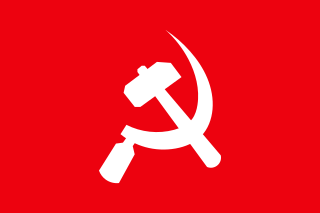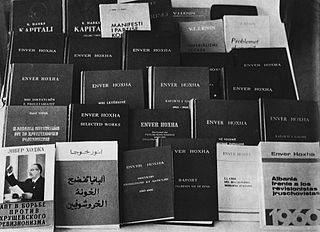Related Research Articles
A communist party is a political party that seeks to realize the social and economic goals of communism through revolution and the establishment of a strong state. The term communist party was popularized by the title of the Manifesto of the Communist Party (1848), by Karl Marx and Friedrich Engels. As a vanguard party, the communist party guides the political education and development of the working class (proletariat); as the ruling party, the communist party exercises power through the dictatorship of the proletariat. Vladimir Lenin developed the idea of the communist party as the revolutionary vanguard, when social democracy in Imperial Russia was divided into ideologically opposed factions, the Bolshevik faction and the Menshevik faction. To be politically effective, Lenin proposed a small vanguard party managed with democratic centralism, which allowed centralized command of a disciplined cadre of professional revolutionaries; once policy was agreed upon, realizing political goals required every Bolshevik's total commitment to the agreed-upon policy.
Several different left-oriented organizations in Peru refer to themselves as communist (comunista) parties, movements, organizations, groups, etc. Some are still active, under their original or other appellation, some have merged or split, and some have ceased operating.

The Workers' Party, is a Marxist-Leninist political party in Tunisia. Legalized only in 2011, it participates in the Popular Front coalition, which is represented in the Assembly of the Representatives of the People. The party's long-term leader is general secretary Hamma Hammami.

The Communist Party of India (Marxist–Leninist) Liberation is a communist political party in India.

The Jordanian Communist Party is a communist party in Jordan, founded in 1948. Its current general secretary is Dr. Munir Hamarana. It publishes al-Jamahir.

Communist Party of Nepal (Soviet), was an underground political party in Nepal. It was founded 1978 by the All Nepal Communist Revolutionary Coordination Committee (Marxist-Leninist). The founding congress was held December 26, 1978-January 1, 1979. The first general secretary of CPN (ML) was C.P. Mainali.
The National Democratic Rally or National Democratic Gathering is a banned opposition alliance in Syria, comprising five political parties of a secularist, pan-Arabist, Arab nationalist and socialist bent.
Palestinian Arab Front (PAF) is a minor Palestinian Arab Nationalist faction. PAF is a member of the Palestine Liberation Organization.
Workers Committee for National Liberation – Political Organisation for the Working Class was a militant anti-imperialist labour organisation in Egypt. The emergence of WCNL was part on an ongoing radicalization and upsurge of the national movement in Egypt 1945-1946.
Iskra was a communist organization in Egypt. Iskra was founded in 1942 by Hillel Schwartz. In the initial phase of its existence, the membership of Iskra was a small group of less than 100.
The Democratic Movement for National Liberation was a communist organization in Egypt from 1947 to 1955. HADITU was led by Henri Curiel. The movement followed the line of the National Democratic Revolution.
Al-Jamahir was an Arabic language weekly newspaper and the official organ of the Democratic Movement for National Liberation a communist organization in Egypt between 1947 and 1955.
Youssef Darwish was an Egyptian labour lawyer, communist and activist. During his years of political activism, he was frequently accused of communist subversion and imprisoned, spending around 10 years of his life in jail. Of Jewish background, he converted to Islam in 1947. He was one of the few from the Karaite Jewish community to remain in Egypt after the establishment of Israel in 1948.
The Unified Egyptian Communist Party was a political party in Egypt. The party was founded in February 1955 through the merger of the Democratic Movement for National Liberation (HADITU) and six splinter organizations. The talks regarding the merger were held without the HADITU leader Henri Curiel being aware of them. Once the merger was finalized Curiel and HADITU leader Kamal Abd al-Halim were excluded from membership in the new party. Curiel and Abd al-Halim were allowed to enter the party in 1956, and after the 1956 war Curiel was included in its Central Committee.
The United Egyptian Communist Party was a political party in Egypt. The party was founded in 1957, through the merger of the Unified Egyptian Communist Party and the Egyptian Communist Party . At the time of the merger a declaration was issued, calling for unity for national revolution amongst the Egyptian communists, working class and national bourgeoisie and for defense of the government of Gamal Abdul Nasser. The declaration also stated that the party would seek unification with the Workers and Peasants Communist Party at a later stage.
The People's Will Party is a political party in Syria.

Hoxhaism is a variant of anti-revisionist Marxism–Leninism that developed in the late 1970s due to a split in the Maoist movement, appearing after the ideological dispute between the Communist Party of China and the Party of Labour of Albania in 1978. The ideology is named after Enver Hoxha, a notable Albanian communist leader.
The Egyptian Communist Party, often referred to as the Raya group after its publication ar-Rayat ash-Sha'ab, was a communist party in Egypt founded in late 1949.
References
- 1 2 3 4 5 6 7 8 9 10 11 12 Tareq Y. Ismael; Rifa'at El-Sa'id (1 September 1990). The Communist Movement in Egypt, 1920-1988. Syracuse University Press. pp. 44–45, 109. ISBN 978-0-8156-2497-4.
- 1 2 3 4 عادل غنيم (1 May 2013). جمال عبد الناصر وعصره. دار المعارف. pp. 285–286. ISBN 978-977-02-7796-6.
- ↑ Henri Curiel (1988). Awrāq Hinrī Kūryīl wa-al-hạrakah al-shuyūʻīyah al-Misṛīyah. Sīnā. p. 39.
- ↑ Tōyō Bunko (Japan); Tōyō Bunko (Japan). (2003). Memoirs of the Research Department of the Toyo Bunko: (the Oriental Library). Tôyô Bunko. p. 89.
- ↑ David A. McMurray; Amanda Ufheil-Somers (2013). The Arab Revolts: Dispatches on Militant Democracy in the Middle East. Indiana University Press. p. 86. ISBN 0-253-00968-5.
- ↑ الهلال. دار الهلال. 2000. p. 49.
- 1 2 3 4 5 6 7 8 9 Joel Beinin (22 October 1990). Was the Red Flag Flying There? Marxist Politics and the Arab-Israeli Conflict in Eqypt and Israel 1948-1965. University of California Press. pp. 185–186, 294. ISBN 978-0-520-07036-3.
- 1 2 3 Diaspora: A Journal of Transnational Studies. Oxford University Press. 1992.
- ↑ قصير، أحمد (2008). حدتو، ذاكرة وطن: حول منظمة الحركة الديمقراطية للتحرر الوطني. دار العالم الثالث،. p. 79.
- ↑ صلاح عيسى (1 January 2010). شخصيات لها العجب: ذكريات.. تراجم.. دراسات.. ووثائق. Nahdet Misr Publishing Group. p. 438. GGKEY:BZP6ZSYDD1F.